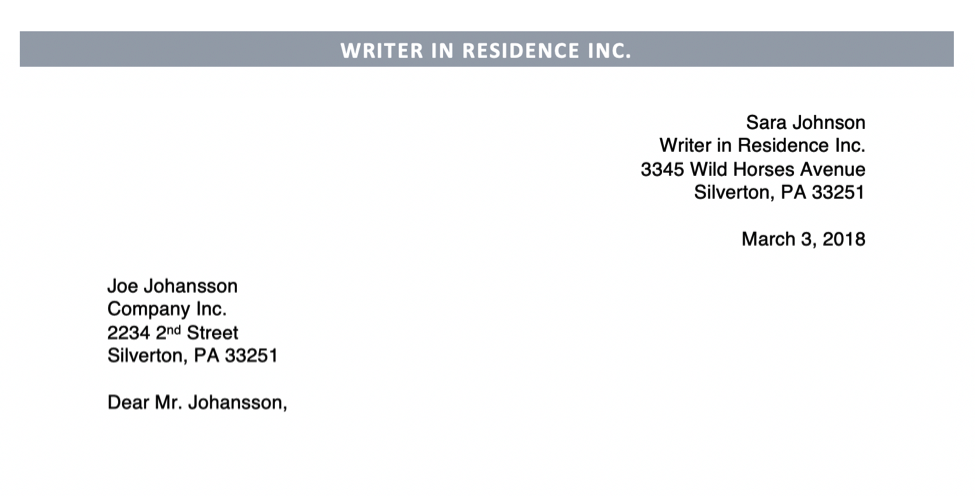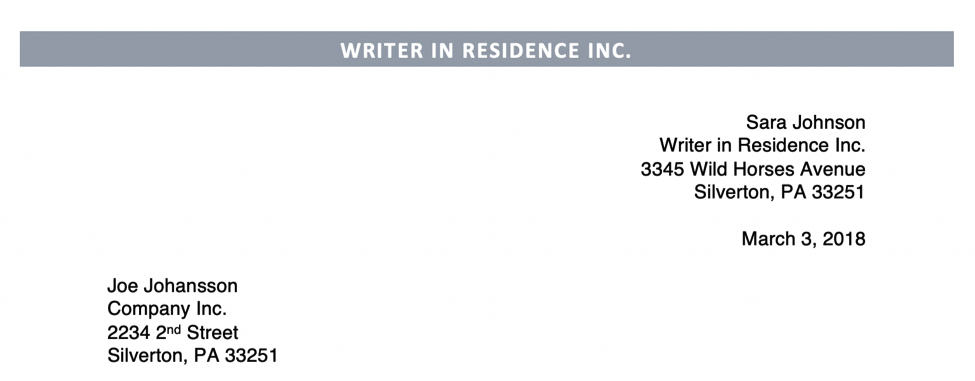In these fast-paced days of emailing and texting, most people may feel that the practice of writing letters (whether formal or personal) has gone by the wayside. However, it’s still important to know how to write a letter, as well as how to format one. One of the most important parts of showing people you understand how to create a formal letter is knowing how to head a letter.
A letter heading is the part of the letter that introduces you to your recipient as well as gives them some important information about you, such as your address. The art of writing the heading of a letter is specific to different types of letters, but more than simply being protocol, knowing how to write the heading of a letter also
- conveys professionalism to your reader;
- makes it easy to reply to your message, as there is no need to keep the envelope when all the information is on one piece of paper; and
- often ensures you will get a prompt reply, which is very important in today’s world of instant communication.
So now that you understand why it is necessary, it’s time to learn how to write the heading for a letter.
Business Letters
Writing a business letter heading is not the same as writing the heading for a personal letter. Business letters are usually very formal, and you’ll want yours to be as well, especially since you’re choosing to send a letter rather than an email. The business letter heading format, like the format of a business letter itself, is specific and must get across certain information to be considered formal.
1. If you have letterhead, use it!
Some businesses—big or small—already have paper with letter heading formats built in. As a formal letter heading example, this can’t be beat! It’s also done the work of introducing you and giving your reader all the pertinent information, including the name of the company and its address. Sometimes, the letterhead will contain your name as well. Usually, before you start writing the letter itself, the only piece of information you will need to add is the date.
Unfortunately, though, not everyone has letterheads already created for their needs, especially today—when writing formal letters isn’t quite as common. If you don’t have letterhead, it’s still easy to create the proper letter heading format.
2. If you don’t have letterhead, include your address.
The first thing you’ll include when writing a business letter heading is your address. This means your formal address with your street number, name, city, state, and zip code.

If you have a PO (short for “post office”) box number, skip writing your street number and name and simply write “PO Box” followed by the number. Then, follow the number with your city, state, and zip.

If you live in an apartment, make sure to include your apartment number under the first line of your address.

After the full address, many people include a phone number or email address, although this isn’t mandatory. After all, you’ve written a letter to this person, so don’t you expect a letter in return?
Make sure that when you write the address and any additional information that you block all the text to the right side of your letter. This is the expected way to format your own address when writing the heading of a letter.
3. Write the date.
Next, professional letter heading format dictates that you include the date. You don’t want people to forget when they received your letter, so make sure to remind them. Leave a line between the address and the date. You’ll find that leaving this space makes the letter look cleaner and more formal—plus it makes the date easier to pick out.

4. Write the recipient’s address.
Always include the recipient’s address when you’re writing a formal or business letter heading. You’ll need to include all the same information you included when you wrote your own address. Here are some rules for what to include and how to format the recipient’s address:
- Do not indent the recipient’s address, but do leave two spaces below the date.
- Block this address to the left instead of the right.
- Always address the letter to someone specific within the company if possible.
- If applicable, include the name of the company beneath the name of the individual but before the address.
5. Leave a space before writing the salutation.
You’re almost done! Leave a space before the salutation to finish your heading. Then, write the salutation. Of course, you’ll want to use a formal salutation rather than a casual one, but that’s a completely separate issue. In fact, it’s one we discuss at length in another post.
 Personal Letters
Personal Letters
As you may have already guessed, how to write the heading of a letter changes when you’re writing a personal letter. For one thing, you’re bound to be much closer to the recipient, so some information may not be necessary. And for another, you already know how to write the heading for a letter for business, and this is a much more casual, laid-back alternative.
Finally, personal letters tend to be handwritten. This means your heading might be handwritten too, which can affect letter heading spacing, letter heading format, as well as simply how to write the heading for a letter.
1. Begin with your address unless you’re certain the recipient knows it.
You may not need to include your address the way you did in a formal letter heading example. In fact, your recipient may already know your address well. You may even swap letters with them often. If this is the case, you won’t need to include an address like you would in a formal letter heading format.
However, you may not be sure if your recipient knows your address. If you’re not positive they do, include it in the upper right-hand corner like you would when writing a business letter heading. Furthermore, if you have stationery with this already printed on it, great! If not, write it out yourself, either typed or handwritten.

2. Add the date.
Letter heading spacing is still important in a personal letter, but it’s a bit different. Leave two spaces between your address and the date. If you didn’t include your address, include just the full date in the upper right-hand corner of the letter.

3. Go directly to the salutation.
Unlike when you were learning how to head a letter for formal or business correspondence, you won’t need to include the recipient’s address. Instead, you can skip forward to the salutation. This can be gentler and more familiar than one you would use when writing a business letter heading. And for this one, you’ll also need to leave two spaces between the date and the salutation.

Hybrid Letters
Of course, not all types of letters fall into one of these categories. These can include formal letters that are handwritten, such as fan mail to movie stars or letters of complaint to a company. You’ll still want to include the recipient’s address in this case.
Other times, you may be writing your first personal letter to someone, so you don’t want to seem too familiar right off the bat. In this situation, a formal letter heading example may be better. However, you still won’t necessarily need to include the recipient’s address.
Why Write Letters in the Age of Email
If you’ve come here hoping to learn more about how to head a letter or letter heading spacing or to see some formal letter heading examples, we hope we’ve been able to assist. However, some people may still be wondering why they might ever need to write letters when emails are so much easier—not to mention instant.
The art of letter writing has been around a long time. Knowing how to write a proper letter allows you to communicate with people in a number of ways. Those who know how to write the heading for a letter can correspond with people properly, based on the situation and their relationship. There will always be times when writing a letter is more efficient, effective, or appropriate to the situation than sending an email. Thus, it’s important to know how to do so when these times come.
Like this post? Check out some more about writing letters:
How to Write an Official Letter
How to Write a Killer Query Letter









